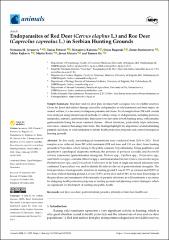Endoparasites of Red Deer (Cervus elaphus L.) and Roe Deer (Capreolus capreolus L.) in Serbian Hunting Grounds

View/
Date
2024Author
Jovanović, Nemanja
Petrović, Tamaš
Nenadović, Katarina
Bugarski, Dejan
Stanimirović, Zoran
Rajković, Milan
Ristić, Marko
Mirčeta, Jovan
Ilić, Tamara
Metadata
Show full item recordAbstract
In this study, parasitological examinations were conducted from 2019 to 2023. Fecal
samples were collected from 289 wild ruminants (158 red deer and 131 roe deer) from hunting
grounds in Vojvodina, which belong to the public company Vojvodinašume. Using qualitative and
quantitative coprological diagnostic methods, the presence of protozoa (coccidia and Buxtonella
sulcata), nematodes (gastrointestinal strongyles, Trichuris spp., Capillaria spp., Dictyocaulus spp.,
and Muellerius spp.), cestodes (Moniezia spp.), and trematodes (Fasciola hepatica, Fascioloides magna,
Paramphistomum spp., and Dicrocoelium dendriticum) in the form of single and mixed infections were
confirmed. Coproculture was used to identify the infective larvae of gastrointestinal strongyles. The
total prevalence of endoparasitic infections in hunting ground 1 was 89.77% in red deer and 92.85% in
roe deer, while in hunting ground 2, it was 72.97% in red deer and 85.96% in roe deer. Knowledge of
the prevalence and assessment of the intensity of parasitic infections in wild ruminants is necessary
for designing health protection programs in hunting grounds and planning control strategies, which
are significant for this branch of hunting and public health.
